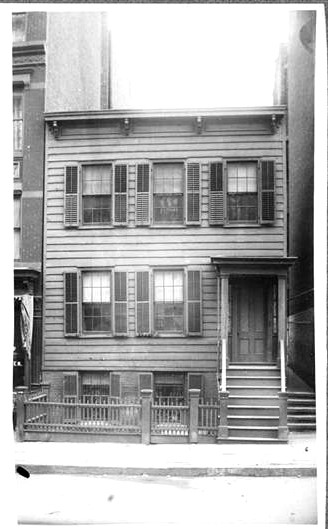from the collection of the Museum of the City of New York
After the New York and Harlem Railroad was extended along Fourth Avenue in the 1830's, a hamlet grew up around the 86th Street station. During the 1850's an influx of German and Irish immigrants settled in the village, many of them hired to build the Croton Aqueduct. At some point around the time of the Civil War it became known as Yorkville. Eventually Yorkville would rival, then overtake the Lower East Side as the center of the German immigrant community.
Around 1855 a two-story wooden house was erected at what would be later numbered 210 East 85th Street. Its simple clapboard front, three bays wide, wore a straightforward bracketed wooden cornice. In the rear yard was a smaller house, used for rental income.
In 1863, 210 East 85th Street was home to Peter Loram, who was in the milk business; and the following year Thomas J. Addie and his family lived in the house. He was still enrolled in the army, having just returned from serving in the Civil War.
Before 1870 Catherine Johnson purchased 210 East 85th Street. The widow of John Johnson, she shared the house with her two adult sons George W. and William H. George was listed as a painter, and William worked as a clerk in City Hall downtown.
Despite what must have been tight conditions in the small house, in 1872 and 1873 Catherine took in two boarders, Charles E. Higham and Paul B. Williams. Both were in the grocery business on Fourth Avenue, and were presumably partners.
William Johnson was on his way home on the Third Avenue streetcar in November 1874, when he caught Gennova Costa in the act of picking his pocket. Johnson held Costa until a policeman was found to arrest him. The would-be thief was held on a staggering $1,000 bail (around $26,500 in 2023) awaiting trial.
Catherine continued to take in two boarders in the main house. In 1876 they were two Irishmen, Patrick Callaghan, a laborer; and Thomas G. McQuaide, a clerk. Her tenants in the rear house that year were John T. Richards and Joanna Duggan, who took in washing.
By then, many of the quaint wooden houses and shops of Yorkville were being replaced by brownstones and apartment buildings. It seems that the Johnson family considered replacing their frame house with a more substantial structure. On July 10, 1877, the Board of Examiners granted "permission to erect building, No. 210 East Eighty-fifth street," to William H. Johnson.
For whatever reason, although plans were submitted, the project was never begun. The Johnsons were still living in the wooden house in 1881 when William was transferred to the Department of Public Works, now earning $1,000 per year (about $29,500 today). The family left not long afterward.
By the first years of the 1890s, Morris Diamond lived at 210 East 85th Street. His art store was located at 329 East 89th Street. An artist himself, he produced unique pen-and-ink portraits of well-known figures, the prints of which he sold at his shop. Diamond's distinctive portraits were composed of the sitter's biographical information in tiny words.
In its July 1892 issue, The Menorah reported on Diamond's latest work, a portrait of philanthropist Baron Maurice de Hirsch, saying in part:
Within the outlines of an excellent likeness, the artist has inscribed the baron's biography, composed of nine thousand words with such small yet distinct chirography, that the aid of a microscope renders it clearly legible and gives an idea of the masterly execution of this difficult feat, on whose production the artist labored four months.
The article pointed out that Diamond's portraits of President Benjamin Harrison and former President Grover Cleveland were available at his shop as well.
Morris Diamond's infinitesimal handwriting made up his portrait of Benjamin Harrison. collection of the National Portrait Gallery, Smithsonian Institution
At the turn of the century, the 85th Street property was owned by John A. Stillman. He sold it in February 1905 to operators Geiger & Braverman.
The sale signaled the end of one more of Yorkville's wooden houses. A demolition permit was granted within months and a six-story apartment and store building was erected on the site.
no permission to reuse the content of this blog has been granted to LaptrinhX.com



.png)
Tom: You you write of a small hamlet growing up around Fourth Avenue and 86th Street. It included a small courthouse, but with all my research on New York City courthouses, I have never come across a photograph of it.
ReplyDeleteDo you mean the Yorkville Police Court on 57th and Third Avenue? The NYPL has a depiction of that structure.
Delete